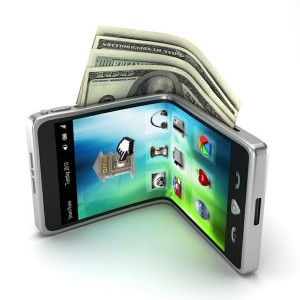When it comes to the financial industry, the digital revolution is an ever evolving process made up of small steps and giant leaps into virtually unknown territory. Between the time this article goes through its final edits, and the time it is published, things will have already changed in more than one way. New products, processers, and systems are released to the public on a daily basis, however, only a select few are successful in breaking through the static and catching the customer’s attention. Mobile electronic payments are forcing their way to the forefront of the industry, vying for consumer recognition and corporate acceptance.
The electronic payment may not be new in theory or even in development, but the details are ever evolving when it comes to immediacy and platform. The mobile electronic payment has become far more commonplace in 2014 than ever before as more and more corporations begin delivering their own versions to the marketplace. While Google Wallet has been available since September of 2011, the multinational technology company, Apple Inc, just released their mobile payment platform, Apple Pay, in the fall of this year. Apple Pay is gaining ground in the industry due to the public’s existing excitement over the company as a whole, and the immediate compatibility with the iPhone6, which was sold ten million times within the first three days of its release. Companies such as Venmo and Square, however, were not preexisting giants in the technology marketplace, but were able to stand out as secure, user friendly, effective platforms for direct payments through mobile devices.
Merchants and service providers have been perceptive to the changing payment platforms, as they encourage consumerism and make it easier for shoppers to make purchases. When Apply Pay launched in October of 2014, 220,000 companies were registered as participating vendors, encouraging customers to use the mobile payment service at check out in their brick and mortar stores. While mobile payments may not be accepted at every retailer around the world, the reach is growing rapidly. The mobile payment company, Square—who officially stepped foot in the marketplace in 2010—comes at the industry from a merchant’s perspective. Products Square Reader and Square Stand enable merchants and sellers to turn their mobile devices into point of sale systems using attached hardware that syncs with the company’s Square application. The mobility and accessibility of the Square Reader, which is inserted into the headphone jack of a mobile phone or tablet, allow for vendors anywhere, from art shows and farmers markets, to the service industry and retail operations, to accept credit and debit cards as forms of payment. Not only does this provide customers with the convenience of using payment cards, it encourages purchases that may not have otherwise been made, if only cash were accepted.
The main objective for innovators and creators of mobile electronic payments is to maximize efficiency and immediacy. However, the key to any successful payment platform is security. Without security, consumers will bypass convenience in order to protect themselves and their personal information. Companies like Apple and Square have made security a top priority in the mobile payment field, through things like Touch Identification technology and dynamic security codes.
Because Square has seemingly protected the privacy of its millions of users, it is no surprise that other companies look to them for expertise in the arena. The popular photo sharing mobile application, Snap Chat has recently released a program in partnership with Square that allows users to share money through the app. Snap Cash users simply insert the currency amount and use a specific button on the interface to send money directly from their linked debit or check card to the friend’s bank account. While Snap Chat’s security has proven to have its holes in the past, Snap Cash’s reliance on Square’s encryption and data storage provides a level of reassurance to users that their personal information is secure. Existing competitor Venmo, the money sharing social networking app—which uses 256-bit encryption to allow users to not only send money to one another, but open up their bank accounts to their most trustworthy allies through the “trust” feature—has been in production since 2009. While the two apps have similar features and strive to reach the same result, (the sharing of money between friends through their mobile applications) Venmo’s sole purpose is to provide this specific service. Snap Chat, however, is working with an already enormous existing customer base. Because the app is used as a social media and messaging app at its core, the addition of mobile payments could go either way for users. Some users may believe that because they are already using the app to communicate with friends, it comes as the ideal platform to share finances as well. However, other users may be put off by the idea that their social and financial worlds are colliding, making it just as easy to send money to one another as it is to send “selfies”. While the majority of people using mobile apps to send money back and forth may not trust the applications when it comes to triple and quadruple digit figures, the customer base for Snap Chat falls majorly between the 13 and 23 age range, which typically fall into the lower percentile for annual earnings. For users of Venmo and Snap Cash, it has become instantly easier to split meals, bar tabs, cab fares, and purchases without the use of physical cash.
to their most trustworthy allies through the “trust” feature—has been in production since 2009. While the two apps have similar features and strive to reach the same result, (the sharing of money between friends through their mobile applications) Venmo’s sole purpose is to provide this specific service. Snap Chat, however, is working with an already enormous existing customer base. Because the app is used as a social media and messaging app at its core, the addition of mobile payments could go either way for users. Some users may believe that because they are already using the app to communicate with friends, it comes as the ideal platform to share finances as well. However, other users may be put off by the idea that their social and financial worlds are colliding, making it just as easy to send money to one another as it is to send “selfies”. While the majority of people using mobile apps to send money back and forth may not trust the applications when it comes to triple and quadruple digit figures, the customer base for Snap Chat falls majorly between the 13 and 23 age range, which typically fall into the lower percentile for annual earnings. For users of Venmo and Snap Cash, it has become instantly easier to split meals, bar tabs, cab fares, and purchases without the use of physical cash.
Mobile payment processing is on the rise, and with the inclusion of payment processing into social and more consumer based platforms, there doesn’t appear to be an end in sight. Whether you are a merchant or a customer, the financial services industry is constantly developing ways to make the exchange of funds for goods and services easier and faster than ever before. With a simple push of a button, money is transferred in a snap.



